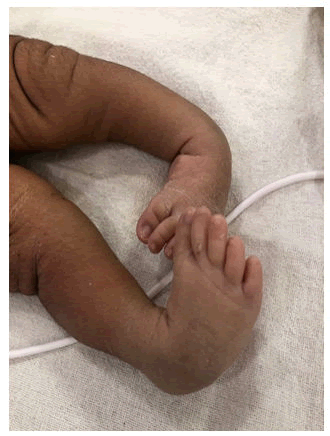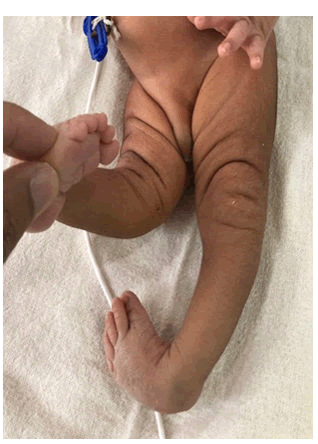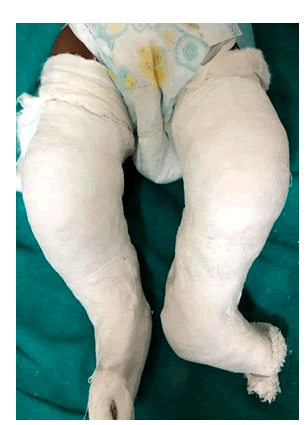Case Report - (2022) Volume 10, Issue 5
An Unusual Case of Neonate with Unilateral Congenital Genu Recurvatum with Bilateral Club Foot with Cutis Laxa Syndrome
Mahaveer Singh Lakra1*, Sagar A Karotkar1, Bhavana Lakhkar1, Sham B Lohiya2 and Ashwini Lakra3
*Correspondence: Mahaveer Singh Lakra, Department of Neonatology, Jawaharlal Nehru Medical College, Datta Meghe Institute of Medical Sciences, Sawangi Meghe, Wardha, Maharashtra State, India, Email:
Abstract
Congenital genu recurvatum is a rare disorder of neonatal life with an incidence of 1 in 100,000 per live birth. It may be isolated or may be associated with other skeletal anomalies or syndromes. It is diagnosed at birth by clinical examination and hyperextension at the knee joint and skin laxity. The association of genu recurvatum with club foot and cutis laxa is a very rare entity. A full-term male baby born to a prim gravida having oligohydramnios in the antenatal period, presented to us with skeletal abnormalities respiratory distress with hyperextension of the right knee with no flexion, bilateral club foot, and loose wrinkled skin. Later on, the baby developed respiratory distress, tachypnoea, grunting which required respiratory support. He also had an paralytic ileus and undescended testis with chest and spine deformity. The skin over his chest, soles, and palms was very lax having wrinkles. Finally the diagnosis of genu recurvatum with congenital talipes equinovarus with cutis laxa syndrome was made with other unusual associations. The respiratory emergency and paralytic ileus were managed by the neonatologist. Gradual corrective serial casting was done and the deformity corrected over time by multidisciplinary team approach.Keywords
Genu recurvatum, Cutis laxa syndrome, Packaging phenomenon, Serial casting, Multidisciplinary teamIntroduction
Congenital genu recurvatum is a rare deformity of knee joint seen in a newborn, characterised by unusual extension and limited joint flexion at knee [1,2]. New-borns with isolated congenital genu recurvatum with or without other associated limb or skeletal abnormalities has been reported [3]. Sometimes other connective tissue disorders such as bone, ligaments, joints, skin, other body organs, and lax wrinkle skin may be associated with joint laxity with skeletal deformities [4,5]. This case report aimed at enlightening with the unusual association of congenital genu recurvatum with bilateral club foot with cutis laxa syndrome with pectus and skeletal deformity and with other association and to increase awareness about this entity about the successful management of the deformity by multidisciplinary team approach
Case Presentation
A full-term male baby weighing 2.7 kg was born to a 38-year-old prim gravida by emergency caesarean section in view of fatal bradycardia. No history of any consanguinity, drug intake, addiction, radiation exposure, fever with rash or lymphadenopathy in the mother. Antenatal ultrasonography showed oligohydramnios but there were no decrease in any foetal movement. There was no significant family history of any muscle weakness in the family. At birth all vitals were stable. Examinations of the cardiovascular system and the central nervous system were normal. On examination, we noticed excessive mobility in the right knee with hyperextension with associated B/L club foot deformity as shown in (Figure 1).
Figure 1: Showing bilateral club foot laxity.
The knee could not be flexed and hyper extension was present with a range of 70-90 degrees movement as shown in (Figure 2).
Figure 2: Hyperextension at knee with skin.
The hip was examined by Barlow’s and Ortolani’s tests, which showed no evidence of any hip dislocation. Patella was barely palpable. There was facial dimorphism, but no cranial or ear abnormalities, eye abnormalities, or visible cutaneous marks were observed. On day 2 of life because of poor respiratory efforts, baby developed difficulty in breathing and was put on CPAP support. Later on, he developed abdominal distension and feed intolerance and diagnosed as a paralytic ileus. On detailed examination, the right scrotum was found empty and on USG of inguinal region showed undescended testes. The right testes were located in the inguinal region and the left was in the iliac fossa. We also noticed loose, elastic skin with excessive wrinkling over the chest, palm, and soles, both suggestive of wrinkling cutis laxa syndrome. All routine blood investigations, Vitamin D level, septic screening, electrolytes, thyroid profile, x-ray chest, and echocardiography were normal. Finally, the diagnosis of unilateral congenital genu recurvatum with B/L CTEV with cutis laxa syndrome with undescended testes with paralytic ileus was made. The gene study could not be done because of rural set up and the financial condition of the patient. The cause of poor respiratory efforts, paralytic ileus, and undescended tests was supposed to be laxity of soft tissue, muscle fibres, and ligaments. We kept the final diagnosis of wrinkled skin syndrome with osteodysplastica syndrome, a variant of cutis laxa [6]. After 15 days of the NICU stay, the baby was discharged in stable condition with a cast on leg for correction of deformity as advised by the orthopedician. The child was followed up till six month and deformity was corrected over time with limb manipulation and serial casting as shown in (Figure 3). As there is no treatment for cutis laxa so we decided to keep the child in follow up and child was doing well at subsequent visits on follow up.
Figure 3: Showing serial casting and follow up at 4 months.
Discussion
Congenital genu recurvatum is a rare disorder of the new born [1,7]. It is diagnosed at birth by clinical examination, bony abnormalities and hyperextension at the knee joint with zero flexion. Radiology and a complete skeletal survey are also needed for confirmation of the diagnosis [8]. It may or may not be associated with other skeletal and limb deformities and dysmorphism. The most common associations are chest deformity, club foot, and dysplasia of the hip [9]. The other associations found are Larsen’s syndrome, arthrogryposis multiplex congenita, myelomeningocele, Ehlers-Danlos syndrome, and some genetic abnormalities [10].
The aetiology may be multifactorial and can be due to extrinsic factors or intrinsic factors in intra uterine life. The possible causes are abnormal breech position in utero, less intrauterine space and oligohydramnios [2-3]. Cutis laxa syndrome is a very rare disease of skin, soft tissue, ligaments, and bones where there is degeneration or elastolysis occurs and mostly associated with poor intradermal uterine growth, wrinkles over skin, hyper extension of joints, facial deformity, club foot and developmental deformity in later parts of life [5]. It has got genetic inheritance and can be because of mutation also [4]. Around 20 cases of cutis laxa syndrome has also been reported by Rajab Anna [7] from Oman in a single family with other different association like with club foot and hip dislocation and growth retardation [11]. In our case the multiple bony deformities like genu recurvatum, bilateral CTEV, pectus and spine deformity, respiratory muscle weakness, paralytic ileus and undescended testes were associated with skin laxity. The skin was found to have increased palmer and sole creases with loosened skin and all these manifestations can be well explained by the common pathology involving soft tissues and collagen fibre involvement. A case was also reported by Tiwari M [12] in preterm baby who also had genu recurvatum with club feet and was managed successfully by serial casting. The packaging phenomenon is the result of compression in utero. It can be a result of external or internal compression of intra uterine structures. Other similar cases of isolated genu recurvatum have also been reported by Lacono [3] and Donaire AR [7] where baby was managed conservatively by physiotherapy. The treatment modalities available for genu recurvatum are conservative and surgical. If knee flexion is possible, gradual corrective casting can be done. The aim of putting a serial cast is to slow correction to avoid hyperextension as it may damage the cartilage and joints [3,10]. Surgical modalities are generally kept in reserve when conservative treatment fails [13].
The baby was managed well by a multimodal team approach, with parents' self-determination. The initial neonatal management was done by neonatologist, surgeon and expert nursing staff. The deformity was corrected by serial casting over the time [14]. With coordinated teamwork, this rare case of genu recurvatum with club foot and cutis laxa syndrome could be managed, and we were able to restore limb function without the development of any residual contractures
Conclusion
Congenital genu recurvatum with club foot and cutis laxa syndrome is a rare association in neonates. By early serial casting and manipulation, deformity can be corrected and surgery can be avoided. The knowledge, association and management of this entity are important for all practising doctors. This baby was well managed by multimodal team approach without having any sequelae or deformity and contracture.
References
- JacobsenK,VopaleckyF.Congenital dislocationof theknee.Acta Orthop Scand1985; 56:1-7.
- Mehrafshan M, Wicart P, Ramanoudjame M, et al. Congenital dislocation of the knee at birth-Part I: Clinical signs and classification.Orthop Traumatol Surg Res 2016; 102:631-633.
- Biswas D, Akter FA, Roy A, et al. Congenital hyper-extension with subluxation of the knees-report of 2 cases.Mymensingh Med J 2014; 23:811-813.
- Arora P, Chakravarty P, Khanna D, et al. Cutis laxa autosomal recessive type II or wrinkly skin syndrome.Indian Dermatol Online J 2016; 7:440-442.
- Patton MA, Tolmie J, Ruthnum P, et al. Congenital cutis laxa with retardation of growth and development.J Med Genet 1987; 24:556-561.
- Rajab A, Kornak U, Budde BS, et al. Geroderma osteodysplasticum hereditaria and wrinkly skin syndrome in 22 patients from Oman. Am J Med Genet A 2008; 15146A:965-976.
- Donaire AR, Sethuram S, Kitsos E, et al. Congenital bilateral knee hyperextension in a well-newborn infant. Res J Clin Pediatr 2017; 1-2.
- Abdelaziz TH, Samir S. Congenital dislocation of the knee: a protocol for management based on degree of knee flexion.J Child Orthop 2011; 5:143-149.
- Elmadag M, Ceylan HH, Erdil M, et al. Congenital Dislocation of Knee.Eur J Gen Med 2013; 10:164-166.
- Katz MP, Grogono BJ, Soper KC. The etiology and treatment of congenital dislocation of the knee. J Bone Joint Surg Br 1967; 49:112-120.
- Al-Gazali LI, Sztriha L, Skaff F, et al. Gerodermia osteodysplastica and wrinkly skin syndrome: are they the same. Am J Med Genet 2001; 101:213-220.
- Tiwari M, Sharma N. Unilateral congenital knee and hip dislocation with bilateral clubfoot-a rare packaging disorder. J Orthop Case Rep 2013; 3:21-24.
- Youssef AO. Limited open quadriceps release for treatment of congenital dislocation of the knee. J Pediatric Orthop 2017; 37:192-198.
- Kampa R, Binks K, Dunkley M, et al. Multidisciplinary management of clubfeet using the Ponseti method in a district general hospital setting.J Child Orthop 2008; 2:463-467.
Author Info
Mahaveer Singh Lakra1*, Sagar A Karotkar1, Bhavana Lakhkar1, Sham B Lohiya2 and Ashwini Lakra3
1Department of Neonatology, Jawaharlal Nehru Medical College, Datta Meghe Institute of Medical Sciences, Sawangi Meghe, Wardha, Maharashtra State, India2Department of Pediatrics, Jawaharlal Nehru Medical College, Datta Meghe Institute of Medical Sciences, Sawangi Meghe, Wardha, Maharashtra State, India
3Department of Pediatrics, Datta Meghe Medical College and SMHRC Wanadongri, Nagpur, India
Citation: Mahaveer Singh Lakra, Sagar A Karotkar, Bhavana Lakhkar, Sham B Lohiya, Ashwini Lakra, An unusual case of neonate with unilateral congenital genu recurvatum with bilateral club foot with cutis laxa syndrome, J Research Med Dent Sci, 2022, 10 (5):000-000.
Received: 21-Feb-2022, Manuscript No. JRMDS-22-4901; , Pre QC No. JRMDS-22-4901; Editor assigned: 23-Feb-2022, Pre QC No. JRMDS-22-4901; Reviewed: 09-Mar-2022, QC No. JRMDS-22-4901; Revised: 22-Apr-2022, Manuscript No. JRMDS-22-4901; Published: 02-May-2022



